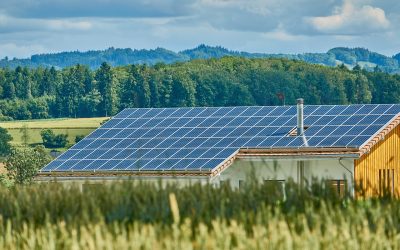Are you looking for ways to support green and sustainable living? Well, look no further! In this article, we will explore various strategies and initiatives that you can adopt in order to make a positive impact on the environment. From making simple changes in your daily habits to advocating for policy changes, there are countless ways for you to contribute towards a greener future. So, let’s get started and discover how you can be part of the solution!
Benefits of Green and Sustainable Living
Improving Environmental Health
Green and sustainable living practices have numerous benefits for environmental health. By reducing pollution and carbon emissions, these practices help combat climate change and improve air quality. Sustainable agriculture methods reduce pesticide usage, minimizing water pollution and preserving soil quality. By embracing renewable energy sources, such as solar and wind power, we can reduce our dependence on fossil fuels and mitigate the negative impacts of traditional energy generation on the environment.
Reducing Energy Consumption
Adopting green and sustainable practices helps in reducing energy consumption. Energy-efficient technologies and appliances minimize energy wastage, resulting in lower electricity bills and a reduced carbon footprint. Simple changes like using LED lights, insulating homes, and utilizing natural light can make a significant difference in energy consumption. Additionally, incorporating smart home technology allows for optimized energy usage and remote control over energy-consuming devices.
Conserving Natural Resources
Green and sustainable living encourages the responsible use and conservation of natural resources. By reducing water usage through techniques like rainwater harvesting and using water-efficient fixtures, we can conserve this precious resource. Sustainable forestry and responsible logging practices ensure the preservation of forests and biodiversity. Focusing on the three Rs – reduce, reuse, and recycle – helps minimize waste and preserve natural resources for future generations.
Promoting Health and Well-being
Green and sustainable living practices contribute to improved health and well-being. By reducing exposure to pollutants and toxins, we can minimize the risk of respiratory illnesses and other diseases. Embracing organic and locally sourced food enhances nutritional value and reduces exposure to harmful pesticides. Green spaces, such as parks and gardens, promote physical activity and mental well-being. Sustainable transportation options, like cycling and walking, improve cardiovascular health and reduce air pollution.
Creating Sustainable Communities
Green and sustainable living fosters the development of sustainable communities. By incorporating green spaces, community gardens, and public transportation systems, we can create environments that prioritize sustainable living. Integration of green building standards ensures energy efficiency and eco-friendly construction practices. Sustainable community initiatives encourage collaboration, resource sharing, and local economic development. By creating sustainable communities, we can enhance quality of life and ensure a sustainable future for generations to come.
Government Initiatives
Investment in Renewable Energy
Governments worldwide are recognizing the importance of renewable energy in combating climate change. Through various incentives and investments, they are encouraging the development and implementation of renewable energy sources. This includes financial support for solar and wind power projects, research and development grants, and tax incentives for individuals and businesses adopting renewable energy technologies. By investing in renewable energy, governments promote job creation, energy independence, and a cleaner, more sustainable future.
Implementation of Green Building Standards
To promote sustainable construction practices, governments are implementing green building standards and regulations. These standards focus on energy efficiency, waste reduction, and the use of eco-friendly materials. Through incentives and certifications, such as LEED (Leadership in Energy and Environmental Design), governments encourage builders and developers to adopt sustainable building practices. Green buildings not only minimize environmental impact but also provide healthier indoor environments and long-term cost savings.
Promotion of Sustainable Transportation
Governments play a crucial role in promoting sustainable transportation options. This includes investments in public transportation infrastructure, such as buses, trams, and trains, to reduce reliance on private vehicles. Governments also incentivize the adoption of electric vehicles through subsidies and infrastructure development for charging stations. By promoting sustainable transportation, governments reduce air pollution, congestion, and carbon emissions, while improving accessibility and mobility for all citizens.
Development of Eco-friendly Policies
Governments are actively developing and implementing eco-friendly policies to support green and sustainable living. These policies encompass various sectors, including waste management, water conservation, and land use planning. Governments encourage recycling programs, promote water-saving initiatives, and protect natural habitats through legislation and regulations. By prioritizing eco-friendly policies, governments ensure responsible resource management and mitigate the negative impacts of human activities on the environment.
Support for Circular Economy
Governments are increasingly recognizing the importance of transitioning from a linear economy to a circular economy. A circular economy aims to eliminate waste and maximize the use of resources through recycling, reusing, and repairing. Governments are implementing policies that promote sustainable production and consumption patterns, encourage the development of recycling infrastructure, and support businesses that embrace circular economy principles. By supporting the transition to a circular economy, governments promote resource efficiency, reduce waste, and create new economic opportunities.
Private Sector Engagement
Corporate Social Responsibility
Private sector engagement in green and sustainable initiatives is essential for driving change. Many companies are adopting corporate social responsibility (CSR) practices that prioritize sustainability and environmental stewardship. These initiatives include reducing carbon emissions, adopting sustainable supply chain practices, and supporting community development projects. Through CSR, companies demonstrate their commitment to social and environmental issues, positively impacting their reputation and brand image.
Transition to Renewable Energy Sources
Private sector entities are increasingly transitioning to renewable energy sources to reduce their carbon footprint. Companies are investing in solar panels, wind turbines, and other renewable energy technologies to power their operations. This not only reduces their environmental impact but also provides long-term cost savings through reduced energy bills. By embracing renewable energy, businesses demonstrate leadership in sustainability and contribute to the global effort of combating climate change.
Adoption of Sustainable Business Practices
Private companies are adopting sustainable business practices that prioritize environmental responsibility. This includes minimizing waste generation, promoting recycling and upcycling, and reducing water usage. Sustainable business practices also involve sourcing materials ethically, supporting fair trade, and reducing the use of harmful chemicals and pollutants. By embracing sustainability, businesses reduce their environmental impact and contribute to the well-being of local and global communities.
Green Investments and Financing
Private sector engagement in green investments is crucial for accelerating the transition to a sustainable economy. Investors are increasingly funding sustainable projects, renewable energy startups, and eco-friendly technologies. Financial institutions are offering green loans and financing options to encourage sustainable business ventures. By directing capital towards green initiatives, private sector entities contribute to the development of innovative solutions and sustainable economic growth.
Partnerships for Sustainability
Collaboration between the private sector, NGOs, and government entities is essential for achieving sustainable development goals. Partnerships allow for shared expertise, resources, and knowledge, leading to more effective solutions. Private companies collaborate with NGOs on community development projects, environmental conservation efforts, and sustainable supply chain initiatives. By working together, different stakeholders can leverage their strengths and make a collective impact on promoting green and sustainable living.
Educational Programs and Awareness Campaigns
Promoting Environmental Education
Education plays a vital role in creating awareness and driving behavior change towards sustainability. Governments and educational institutions are implementing environmental education programs at all levels, from primary schools to universities. These programs provide knowledge and understanding of environmental issues, promote sustainable practices, and foster an environmentally conscious mindset. Environmental education empowers individuals to make informed choices and actively participate in creating a sustainable future.
Encouraging Sustainable Lifestyle Choices
Awareness campaigns and educational programs encourage individuals to adopt sustainable lifestyle choices. This includes reducing waste, conserving energy and water, and supporting local and organic products. By providing information on the benefits of sustainable choices, individuals are empowered to make more conscious decisions in their daily lives. Encouraging sustainable lifestyles promotes a collective effort towards environmental protection and a more sustainable society.
Raising Awareness about Climate Change
Raising awareness about climate change is crucial in mobilizing action at all levels. Educational programs and awareness campaigns provide information on the causes and impacts of climate change, emphasizing the need for immediate action. Governments, NGOs, and educational institutions organize events, workshops, and campaigns to educate the public about climate change mitigation and adaptation strategies. By raising awareness, individuals are motivated to take action and support initiatives for a greener and more sustainable future.
Engaging Youth in Environmental Movements
Engaging young people in environmental movements is essential for creating a sustainable future. Educational institutions and youth organizations provide platforms for youth to actively participate in environmental initiatives. Youth-led campaigns, protests, and advocacy efforts raise awareness and drive change on critical environmental issues. By involving youth in decision-making processes and empowering their voices, we ensure that future generations are actively engaged in promoting green and sustainable living.
Collaborations with NGOs and Communities
Collaborations between educational institutions, NGOs, and communities are key to promoting green and sustainable living. NGOs provide expertise, resources, and community outreach capabilities, complementing the efforts of educational institutions. Together, they develop educational programs, community engagement initiatives, and sustainability projects. By collaborating with NGOs and communities, educational institutions maximize their impact and foster a sense of ownership and responsibility within local communities.
Green Technology Innovations
Advancements in Renewable Energy
Advancements in renewable energy technologies are driving the transition to a sustainable energy future. Scientists and researchers are constantly innovating to improve the efficiency and affordability of solar, wind, and other renewable energy sources. This includes developing new materials, energy storage solutions, and grid integration technologies. Advancements in renewable energy not only contribute to a greener energy mix but also create new job opportunities and stimulate economic growth in the clean energy sector.
Smart and Energy-Efficient Homes
Smart home technologies offer innovative solutions for optimizing energy usage and promoting sustainable living. These technologies allow homeowners to control and monitor their energy consumption, lighting, and HVAC systems remotely. Energy-efficient appliances and smart meters help individuals track their energy usage and identify opportunities for improvement. By adopting smart and energy-efficient home technologies, individuals can reduce their energy consumption, lower utility bills, and contribute to a more sustainable future.
Green Transportation Solutions
Green transportation innovations are essential for reducing carbon emissions and promoting sustainable mobility. Electric vehicles (EVs), public transportation systems, and bike-sharing programs are examples of green transportation solutions. The development of EV charging infrastructure encourages the adoption of electric vehicles, providing clean alternatives to traditional gasoline-powered cars. Innovative transportation technologies, such as autonomous vehicles and ride-sharing platforms, also have the potential to revolutionize the way we commute and reduce congestion on the roads.
Waste Management Technologies
Innovations in waste management technologies help mitigate the negative environmental impacts associated with waste disposal. Advanced recycling technologies enable the efficient processing of various waste materials, from plastics to e-waste. Waste-to-energy technologies convert waste into renewable energy, reducing the reliance on fossil fuel-based energy generation. Furthermore, developments in composting and anaerobic digestion improve organic waste management, leading to the production of nutrient-rich fertilizers and biogas for energy production.
Water Conservation Innovations
Water scarcity is a global concern, and innovation in water conservation technologies is crucial for sustainable water management. Water-efficient fixtures, such as low-flow faucets and toilets, help reduce water consumption in homes and businesses. Smart irrigation systems utilize weather data and sensor technology to optimize watering schedules, conserving water in landscaping and agriculture. Moreover, breakthroughs in desalination technologies enable the utilization of seawater as a freshwater resource, particularly in arid regions.
Incentives for Green Living
Tax Benefits for Renewable Energy Adoption
Governments provide tax benefits to individuals and businesses adopting renewable energy technologies. These benefits can include tax credits, deductions, or exemptions for the installation and use of solar panels, wind turbines, and other renewable energy systems. Tax incentives encourage the uptake of renewable energy, making it more financially viable for both residential and commercial purposes. By offering tax benefits, governments incentivize the transition to cleaner and greener energy sources.
Subsidies for Energy-Efficient Appliances
Subsidies for energy-efficient appliances make greener choices more accessible and affordable for consumers. Governments provide financial incentives, rebates, or discounts for purchasing energy-efficient appliances, such as refrigerators, air conditioners, and washing machines. By reducing the upfront cost of energy-efficient appliances, subsidies encourage individuals to upgrade their outdated and energy-consuming devices with more environmentally friendly alternatives.
Grants for Green Projects
Governments and organizations offer grants for green projects in various sectors, including renewable energy, waste management, and sustainable agriculture. These grants provide financial support for research, development, and implementation of innovative green solutions. By funding green projects, governments and organizations stimulate innovation and encourage the adoption of sustainable practices. Grants contribute to the growth of green industries, job creation, and the advancement of environmentally friendly technologies.
Financial Support for Eco-friendly Initiatives
Financial institutions and impact investors provide financial support for eco-friendly initiatives, including sustainable businesses, renewable energy projects, and conservation efforts. Green loans, green bonds, and venture capital investments are some examples of financial support mechanisms for eco-friendly initiatives. By offering financing options, financial institutions contribute to the growth of the green economy and facilitate the transition to more sustainable practices.
Rewards and Recognition for Sustainable Businesses
Governments and organizations recognize and reward sustainable businesses for their commitment to environmental stewardship. Awards and certifications, such as B Corp certification, recognize businesses that meet rigorous criteria for environmental and social responsibility. By acknowledging sustainable businesses, governments and organizations promote best practices, inspire others to follow suit, and create a positive impact on the planet.
Community Engagement and Participation
Local Sustainability Initiatives
Local sustainability initiatives involve grassroots efforts by communities to promote green and sustainable living. These initiatives can include community-led renewable energy projects, waste reduction programs, and local food production initiatives. By engaging with local communities, governments and organizations can tap into local knowledge and resources, fostering a sense of ownership and empowerment among community members. Local sustainability initiatives create opportunities for collaboration, skill-sharing, and collective action towards a sustainable future.
Community Gardens and Urban Farming
Community gardens and urban farming initiatives bring communities together around sustainable food production. These initiatives transform vacant land into productive green spaces, allowing individuals to grow their own food and connect with nature. Community gardens foster a sense of community, promote healthy eating habits, and reduce food miles by sourcing locally. Urban farming initiatives utilize vertical farming, hydroponics, and rooftop gardens to maximize food production in urban areas, contributing to food security and reducing the environmental footprint of food production.
Sharing Economy and Collaborative Consumption
The sharing economy and collaborative consumption promote sustainable resource use by encouraging the sharing, borrowing, and renting of goods and services. Platforms for car-sharing, bike-sharing, and tool libraries reduce the need for individual ownership, minimizing the environmental impact associated with manufacturing and transportation. Collaborative consumption models also extend to accommodation (e.g., home-sharing platforms) and coworking spaces, promoting resource efficiency and fostering community connections.
Supportive Policies for Eco-friendly Communities
Governments can implement supportive policies that enable the development of eco-friendly communities. These policies may include incentives for green building practices, zoning regulations that prioritize green spaces and active transportation infrastructure, and the provision of grants for community-led sustainability initiatives. By establishing supportive policies, governments empower communities to adopt sustainable practices and create thriving eco-friendly neighborhoods that prioritize environmental and social well-being.
Involvement in Green Decision-Making Processes
Encouraging community involvement in green decision-making processes promotes transparency and inclusivity. Consultations, public hearings, and citizen assemblies provide opportunities for community members to share their perspectives, concerns, and ideas regarding sustainable development. By actively involving communities in decision-making, governments can ensure that policies and initiatives align with their needs, priorities, and values. Involving the community fosters a sense of ownership and responsibility, leading to more effective and sustainable outcomes.
Importance of Sustainable Consumption
Reducing Waste and Plastics Pollution
Sustainable consumption practices play a vital role in reducing waste generation and plastics pollution. By embracing the principles of reduce, reuse, and recycle, individuals can minimize waste and divert materials from landfills. Choosing products with minimal packaging, opting for reusable alternatives, and participating in recycling programs are effective ways to reduce waste. Additionally, avoiding single-use plastics and supporting initiatives that promote plastic alternatives contribute to mitigating plastics pollution in our oceans and ecosystems.
Choosing Organic and Locally Sourced Products
Choosing organic and locally sourced products promotes sustainable agriculture, supports local economies, and reduces the carbon footprint associated with long-distance transportation. Organic farming practices prioritize soil health, biodiversity, and the use of natural fertilizers and pest control methods. By opting for locally sourced products, individuals can reduce the environmental impacts associated with transportation while supporting local farmers and producers. Choosing organic and locally sourced products ensures better food quality and contributes to a healthier ecosystem.
Utilizing Renewable Energy and Resources
Utilizing renewable energy and resources in our daily lives is essential for reducing our carbon footprint and dependence on fossil fuels. Installing solar panels, using solar-powered devices, and purchasing renewable energy certificates contribute to the growth of renewable energy infrastructure. Additionally, conserving water, reducing energy consumption, and composting organic waste help us make the most of our resources. By utilizing renewable energy and resources, individuals can actively contribute to a more sustainable future.
Promoting Recycling and Upcycling
Promoting recycling and upcycling helps divert materials from landfills and conserve valuable resources. Individuals can actively participate in recycling programs by separating recyclable materials, such as paper, glass, and plastic, from general waste. Additionally, upcycling involves repurposing and transforming used items into new products, reducing the need for additional resource extraction. By embracing recycling and upcycling, individuals contribute to the circular economy and reduce the strain on natural resources.
Supporting Ethical and Fair Trade Practices
Supporting ethical and fair trade practices ensures social and environmental responsibility throughout the supply chain. Ethical practices prioritize fair wages, safe working conditions, and the absence of child labor. Fair trade certification guarantees that producers receive fair prices for their products, empowering marginalized communities. By supporting ethical and fair trade products, individuals contribute to sustainable livelihoods and social justice, while ensuring that products are produced responsibly and with respect for human rights and the environment.
International Collaborations and Agreements
Paris Agreement and Climate Action
The Paris Agreement is an international treaty aimed at combatting climate change and limiting global warming to well below 2 degrees Celsius. Through this agreement, countries commit to reducing greenhouse gas emissions, enhancing adaptation efforts, and providing financial support to developing nations. International collaborations under the Paris Agreement enable countries to share best practices, exchange technology, and work together towards a sustainable low-carbon future.
United Nations Sustainable Development Goals
The United Nations Sustainable Development Goals (SDGs) provide a global framework for addressing the world’s most pressing social, economic, and environmental challenges. The 17 SDGs cover a wide range of issues, including poverty eradication, climate action, clean energy, and sustainable cities. Collaboration among countries, organizations, and individuals is vital for achieving these goals. By working together, the international community can make significant progress towards creating a more equitable, sustainable, and prosperous world for all.
Global Efforts to Combat Deforestation
Deforestation is a significant contributor to climate change, biodiversity loss, and ecosystem degradation. International collaborations are essential for combating deforestation and promoting sustainable forest management. Initiatives like the REDD+ (Reducing Emissions from Deforestation and Forest Degradation) program provide financial incentives to developing countries for reducing deforestation and preserving forest ecosystems. Through collaborations, countries can share knowledge, expertise, and resources to develop effective strategies for sustainable forest management and conservation.
Cooperation for Sustainable Agriculture
Collaboration among nations is crucial for promoting sustainable agriculture practices and ensuring food security. International organizations, such as the Food and Agriculture Organization (FAO), facilitate cooperation and knowledge exchange among countries. Through initiatives like the UN Decade of Family Farming, countries can work together to support small-scale farmers, prioritize agroecological practices, and promote sustainable farming systems. International cooperation in sustainable agriculture contributes to reducing hunger, poverty, and the environmental impacts of food production.
Sharing Best Practices for Environmental Protection
Sharing best practices for environmental protection enables countries to learn from each other and adopt successful strategies. International platforms, conferences, and forums provide opportunities for countries to share knowledge, research findings, and innovative solutions. Examples include the United Nations Environment Assembly (UNEA) and regional environmental cooperation frameworks. By sharing best practices, countries can enhance their capacity to address environmental challenges, accelerate progress, and develop more effective policies and programs.










